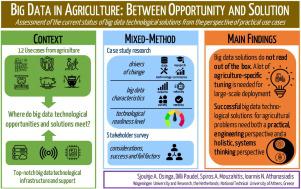Agricultural Systems ( IF 6.6 ) Pub Date : 2021-10-21 , DOI: 10.1016/j.agsy.2021.103298 Sjoukje A. Osinga 1 , Dilli Paudel 1 , Spiros A. Mouzakitis 2 , Ioannis N. Athanasiadis 1

|
CONTEXT
Big data applications in agriculture evolve fast, as more experience, applications, good practices and computational power become available. Actual solutions to real-life problems are scarce. What characterizes the adoption of big data problems to solutions and to what extent is there a match between them?
OBJECTIVE
We aim to assess the conditions of the adoption of big data technologies in agricultural applications, based on the investigation of twelve real-life practical use cases in the precision agriculture and livestock domain.
METHODS
We use a mixed method approach: a case study research around the twelve use cases of Horizon 2020 project CYBELE, varying from precision arable and livestock farming to fishing and food security, and a stakeholder survey (n = 56). Our analysis focuses on four perspectives: (1) the drivers of change that initiated the use cases; (2) the big data characteristics of the problem; (3) the technological maturity level of the solution both at start and end of the project; (4) the stakeholder perspective.
RESULTS AND CONCLUSIONS
Results show that the use cases’ drivers of change are a combination of data-, technology, research- and commercial interests; most have at least a research drive. The big data characteristics (volume, velocity, variety, veracity) are well-represented, with most emphasis on velocity and variety. Technology readiness levels show that the majority of use cases started at experimental or lab environment stage and aims at a technical maturity of real-world small-scale deployment. Stakeholders’ main concern is cost, user friendliness and to embed the solution within their current work practice.
The adoption of better-matching big data solutions is modest. Big data solutions do not work out-of-the-box when changing application domains. Additional technology development is needed for addressing the idiosyncrasies of agricultural applications.
SIGNIFICANCE
We add a practical, empirical assessment of the current status of big data problems and solutions to the existing body of mainly theoretical knowledge. We considered the CYBELE research project as our laboratory for this. Our strength is that we interviewed the use case representatives in person, and that we included the stakeholders’ perspective in our results.
Large-scale deployments need effective interdisciplinary approaches and long-term project horizons to address issues emerging from big data characteristics, and to avoid compartmentalization of agricultural sciences.
We need both an engineering perspective – to make things work in practice – and a systems thinking perspective – to offer holistic, integrated solutions.
中文翻译:

农业大数据:机遇与解决方案之间
语境
随着更多经验、应用、良好实践和计算能力的出现,农业大数据应用发展迅速。对现实生活问题的实际解决方案很少。采用大数据问题解决方案的特点是什么?它们之间的匹配程度如何?
客观的
我们旨在基于对精准农业和畜牧领域的十二个现实实际用例的调查,评估在农业应用中采用大数据技术的条件。
方法
我们使用混合方法:围绕地平线 2020 项目 CYBELE 的十二个用例进行案例研究,从精准耕地和畜牧业到渔业和粮食安全,以及利益相关者调查(n = 56)。我们的分析侧重于四个方面:(1) 引发用例的变革驱动因素;(2)问题的大数据特征;(3) 项目开始和结束时解决方案的技术成熟度;(4)利益相关者的观点。
结果和结论
结果表明,用例的变化驱动因素是数据、技术、研究和商业利益的结合;大多数人至少有研究动力。大数据特征(数量、速度、多样性、真实性)得到了很好的体现,最强调速度和多样性。技术准备水平表明,大多数用例开始于实验或实验室环境阶段,旨在实现现实世界小规模部署的技术成熟度。利益相关者的主要关注点是成本、用户友好性以及将解决方案嵌入他们当前的工作实践中。
采用更匹配的大数据解决方案是适度的。更改应用程序域时,大数据解决方案无法开箱即用。需要额外的技术开发来解决农业应用的特殊性。
意义
我们在现有的主要理论知识体系中添加了对大数据问题现状和解决方案的实用、实证评估。为此,我们将 CYBELE 研究项目视为我们的实验室。我们的优势在于我们亲自采访了用例代表,并且我们在结果中包含了利益相关者的观点。
大规模部署需要有效的跨学科方法和长期项目视野,以解决大数据特征中出现的问题,并避免农业科学的条块分割。
我们既需要工程视角——让事情在实践中发挥作用——也需要系统思维视角——提供整体、集成的解决方案。


























 京公网安备 11010802027423号
京公网安备 11010802027423号